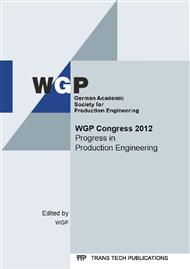[1]
Gümmer, V.: Pfeilung und V-Stellung zur Beeinflussung der dreidimensionalen Strömung in Leiträdern transsonischer Axialverdichter, Fortschritt-Berichte VDI Reihe 7 Nr. 384, VDI Verlag, Düsseldorf, (2005).
DOI: 10.1002/zamm.19770570816
Google Scholar
[2]
Ninnemann, T.; Ng W. -F.: Loss Reduction Using Riblets on a Supersonic Through-flow Fan Blade Cascade. In: Transactions of the ASME, Series I: Journal of Fluids Engineering Vol. 126 (4), p.642–649, (2004).
DOI: 10.1115/1.1667883
Google Scholar
[3]
Bechert, D. -W.; Bartenwerfer, M.: The Viscous Flow on Surfaces with Longitudinal Ribs. Journal of Fluid Mechanics, Vol. 206, pp.105-129, (1989).
DOI: 10.1017/s0022112089002247
Google Scholar
[4]
Siegel, F.; Klug, U.; Kling, R.; Ostendorf, A: Extensive Micro-Structuring of Metals using Picosecond Pulses - Ablation Behavior and Industrial Relevance. Proceedings of LPM 2008, 9th International Symposium on Laser Precision Manufacturing, 17-20 Juni, Quebec, Kanada, (2008).
DOI: 10.2961/jlmn.2009.02.0006
Google Scholar
[5]
Uhlmann, E.; Piltz, S.; Doll, U.: Funkenerosion in der Mikrotechnik. Einsatzgebiete und Verfahrensgrenzen. Werkstatttechnik wt-online, No. 12, pp.733-737, (2004).
DOI: 10.37544/1436-4980-2001-12-733
Google Scholar
[6]
Fischer, S.: Fertigungssysteme zur spanenden Herstellung von Mikrostrukturen. Dr. -Ing. Dissertation, RWTH, Aachen, (2000).
Google Scholar
[4]
Denkena, B.; Köhler, J.; Wang, B.: Manufacturing of functional riblet structures by profile grinding. In: CIRP Journal of Manufacturing Science and Technology, Vol. 3 (1), pp.14-26, (2010).
DOI: 10.1016/j.cirpj.2010.08.001
Google Scholar
[5]
Lietmeyer, C.; Oehlert, K.; Seume J. R.: Optimal application of riblets on compressor blades and their contamination behaviour, Proc. of ASME Turbo Expo, Vancouver, Canada, GT2011-46855, (2011).
DOI: 10.1115/gt2011-46855
Google Scholar
[6]
Weinert, K.; Blum H.; Jansen, T.; Rademacher, A.: Simulation based optimization of NC-shape grinding process with toroid grinding wheels, In: Production Engineering - Research and Development (WGP), Vol. 1 (3), p.245, 252, (2007).
DOI: 10.1007/s11740-007-0042-8
Google Scholar
[7]
Brinksmeier, E.; Riemer, O.; Osmer, J.: Tool Path Generation for Ultra-precision Machining of Free-form Surfaces, In: Production Engineering - Research and Development (2), pp.241-246, (2008).
DOI: 10.1007/s11740-008-0086-4
Google Scholar
[8]
Tönshoff, H.K.; Denkena, B.; Böß, V., Urban, B.: Automated Finishing of Dies and Molds, In: Production Engineering - Research and Development 9 (2), pp.1-4, (2002).
Google Scholar
[9]
Lasemi, A.; Xue, D.; Gu, P.: Recent development in CNC machining of freeformed surfaces: A state-of-the-art review, In: Computer-Aided Design, Vol. 42 (7), pp.641-654, (2010).
DOI: 10.1016/j.cad.2010.04.002
Google Scholar
[10]
Okuyama, S.; Kitajima, T.; Yui, A.: Theoretical Study on the Effect of Form Error of Grinding Wheel Surfaces under Free Form Grinding, In: Key Engineering Materials, Vol. 257-258, pp.147-152, (2004).
DOI: 10.4028/www.scientific.net/kem.257-258.147
Google Scholar
[11]
Xie, J.; Zheng J.H.; Zhou, R.M.; Lin, B.: Dispersed grinding wheel profiles for accurate freeform surfaces, In: International Journal of Machine Tools & Manufacture, Vol. 51, p.536–542, (2011).
DOI: 10.1016/j.ijmachtools.2011.03.002
Google Scholar
[12]
Van der Meer, M.: Bearbeitung keramischer Funktionsflächen für Knieimplantate, Dr. -Ing. Dissertation, Leibniz Universität Hannover, (2012).
Google Scholar
[13]
Wang, B.: Herstellung funktionaler Riblet-Strukturen durch Profilschleifen, Dr. -Ing. Dissertation, Leibniz Universität Hannover, (2011).
Google Scholar
[14]
Kaiser, D.: Product information. Diamantwerkzeuge GmbH, Germany, (2008).
Google Scholar


